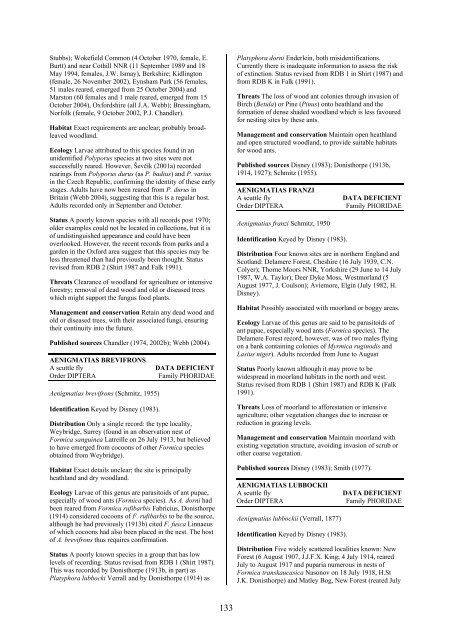Part 2: Nematocera and Aschiza not dealt with by Falk (1991) - JNCC
Part 2: Nematocera and Aschiza not dealt with by Falk (1991) - JNCC
Part 2: Nematocera and Aschiza not dealt with by Falk (1991) - JNCC
Create successful ePaper yourself
Turn your PDF publications into a flip-book with our unique Google optimized e-Paper software.
Stubbs); Wokefield Common (4 October 1970, female, E.<br />
Burtt) <strong>and</strong> near Cothill NNR (11 September 1989 <strong>and</strong> 18<br />
May 1994, females, J.W. Ismay), Berkshire; Kidlington<br />
(female, 26 November 2002), Eynsham Park (56 females,<br />
51 males reared, emerged from 25 October 2004) <strong>and</strong><br />
Marston (60 females <strong>and</strong> 1 male reared, emerged from 15<br />
October 2004), Oxfordshire (all J.A. Webb); Bressingham,<br />
Norfolk (female, 9 October 2002, P.J. Ch<strong>and</strong>ler).<br />
Habitat Exact requirements are unclear; probably broadleaved<br />
woodl<strong>and</strong>.<br />
Ecology Larvae attributed to this species found in an<br />
unidentified Polyporus species at two sites were <strong>not</strong><br />
successfully reared. However, Ševčík (2001a) recorded<br />
rearings from Polyporus durus (as P. badius) <strong>and</strong> P. varius<br />
in the Czech Republic, confirming the identity of these early<br />
stages. Adults have now been reared from P. durus in<br />
Britain (Webb 2004), suggesting that this is a regular host.<br />
Adults recorded only in September <strong>and</strong> October.<br />
Status A poorly known species <strong>with</strong> all records post 1970;<br />
older examples could <strong>not</strong> be located in collections, but it is<br />
of undistinguished appearance <strong>and</strong> could have been<br />
overlooked. However, the recent records from parks <strong>and</strong> a<br />
garden in the Oxford area suggest that this species may be<br />
less threatened than had previously been thought. Status<br />
revised from RDB 2 (Shirt 1987 <strong>and</strong> <strong>Falk</strong> <strong>1991</strong>).<br />
Threats Clearance of woodl<strong>and</strong> for agriculture or intensive<br />
forestry; removal of dead wood <strong>and</strong> old or diseased trees<br />
which might support the fungus food plants.<br />
Management <strong>and</strong> conservation Retain any dead wood <strong>and</strong><br />
old or diseased trees, <strong>with</strong> their associated fungi, ensuring<br />
their continuity into the future.<br />
Published sources Ch<strong>and</strong>ler (1974, 2002b); Webb (2004).<br />
AENIGMATIAS BREVIFRONS<br />
A scuttle fly<br />
Order DIPTERA<br />
Aenigmatias brevifrons (Schmitz, 1955)<br />
Identification Keyed <strong>by</strong> Disney (1983).<br />
DATA DEFICIENT<br />
Family PHORIDAE<br />
Distribution Only a single record: the type locality,<br />
Weybridge, Surrey (found in an observation nest of<br />
Formica sanguinea Latreille on 26 July 1913, but believed<br />
to have emerged from cocoons of other Formica species<br />
obtained from Weybridge).<br />
Habitat Exact details unclear; the site is principally<br />
heathl<strong>and</strong> <strong>and</strong> dry woodl<strong>and</strong>.<br />
Ecology Larvae of this genus are parasitoids of ant pupae,<br />
especially of wood ants (Formica species). As A. dorni had<br />
been reared from Formica rufibarbis Fabricius, Donisthorpe<br />
(1914) considered cocoons of F. rufibarbis to be the source,<br />
although he had previously (1913b) cited F. fusca Linnaeus<br />
of which cocoons had also been placed in the nest. The host<br />
of A. brevifrons thus requires confirmation.<br />
Status A poorly known species in a group that has low<br />
levels of recording. Status revised from RDB 1 (Shirt 1987).<br />
This was recorded <strong>by</strong> Donisthorpe (1913b, in part) as<br />
Platyphora lubbocki Verrall <strong>and</strong> <strong>by</strong> Donisthorpe (1914) as<br />
Platyphora dorni Enderlein, both misidentifications.<br />
Currently there is inadequate information to assess the risk<br />
of extinction. Status revised from RDB 1 in Shirt (1987) <strong>and</strong><br />
from RDB K in <strong>Falk</strong> (<strong>1991</strong>).<br />
Threats The loss of wood ant colonies through invasion of<br />
Birch (Betula) or Pine (Pinus) onto heathl<strong>and</strong> <strong>and</strong> the<br />
formation of dense shaded woodl<strong>and</strong> which is less favoured<br />
for nesting sites <strong>by</strong> these ants.<br />
Management <strong>and</strong> conservation Maintain open heathl<strong>and</strong><br />
<strong>and</strong> open structured woodl<strong>and</strong>, to provide suitable habitats<br />
for wood ants.<br />
Published sources Disney (1983); Donisthorpe (1913b,<br />
1914, 1927); Schmitz (1955).<br />
AENIGMATIAS FRANZI<br />
A scuttle fly<br />
Order DIPTERA<br />
Aenigmatias franzi Schmitz, 1950<br />
Identification Keyed <strong>by</strong> Disney (1983).<br />
DATA DEFICIENT<br />
Family PHORIDAE<br />
Distribution Four known sites are in northern Engl<strong>and</strong> <strong>and</strong><br />
Scotl<strong>and</strong>: Delamere Forest, Cheshire (16 July 1939, C.N.<br />
Colyer); Thorne Moors NNR, Yorkshire (29 June to 14 July<br />
1987, W.A. Taylor); Deer Dyke Moss, Westmorl<strong>and</strong> (5<br />
August 1977, J. Coulson); Aviemore, Elgin (July 1982, H.<br />
Disney).<br />
Habitat Possibly associated <strong>with</strong> moorl<strong>and</strong> or boggy areas.<br />
Ecology Larvae of this genus are said to be parasitoids of<br />
ant pupae, especially wood ants (Formica species). The<br />
Delamere Forest record, however, was of two males flying<br />
on a bank containing colonies of Myrmica ruginodis <strong>and</strong><br />
Lasius niger). Adults recorded from June to August<br />
Status Poorly known although it may prove to be<br />
widespread in moorl<strong>and</strong> habitats in the north <strong>and</strong> west.<br />
Status revised from RDB 1 (Shirt 1987) <strong>and</strong> RDB K (<strong>Falk</strong><br />
<strong>1991</strong>).<br />
Threats Loss of moorl<strong>and</strong> to afforestation or intensive<br />
agriculture; other vegetation changes due to increase or<br />
reduction in grazing levels.<br />
Management <strong>and</strong> conservation Maintain moorl<strong>and</strong> <strong>with</strong><br />
existing vegetation structure, avoiding invasion of scrub or<br />
other coarse vegetation.<br />
Published sources Disney (1983); Smith (1977).<br />
AENIGMATIAS LUBBOCKII<br />
A scuttle fly<br />
Order DIPTERA<br />
Aenigmatias lubbockii (Verrall, 1877)<br />
Identification Keyed <strong>by</strong> Disney (1983).<br />
DATA DEFICIENT<br />
Family PHORIDAE<br />
Distribution Five widely scattered localities known: New<br />
Forest (6 August 1907, J.J.F.X. King; 4 July 1914, reared<br />
July to August 1917 <strong>and</strong> puparia numerous in nests of<br />
Formica transkaucasica Nasonov on 18 July 1918, H.St<br />
J.K. Donisthorpe) <strong>and</strong> Matley Bog, New Forest (reared July<br />
133
















